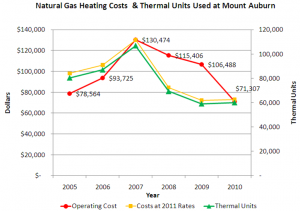Eternally Green: Reducing Energy Use in Historic Buildings
From E-ternally Green: Sustaining Mount Auburn and the World Around Us, Volume 3, Issue 2, June 7, 2011. Authored by Gus Fraser, Director of Facilities
Mount Auburn is making great progress in its ongoing efforts to manage its historic buildings in a more sustainable way. Major investments in new heating systems in several of our historic buildings have provided opportunities to upgrade to more energy efficient equipment and smarter controls that have resulted in significant reductions in energy used for heating and cooling.
Prior to 2007 the Administration Building, Story Chapel, and Bigelow Chapel were all heated by steam, and the aging boilers and pipes w ere using increasing amounts of energy and requiring frequent costly repairs. In 2007 we installed new energy efficient condensing boilers for the Admin Building and Story Chapel and switched to a circulating hot water system with new electronic controls. The controls adjust the temperature of the hot water that circulates through the system according to the rise and fall of the outside air temperature, which means we get more heat in January and February when we need it the most, and less heat during milder fall and spring months. In addition, new programmable thermostats allow us to lower the temperature at night or on weekends when the buildings are unoccupied.
ere using increasing amounts of energy and requiring frequent costly repairs. In 2007 we installed new energy efficient condensing boilers for the Admin Building and Story Chapel and switched to a circulating hot water system with new electronic controls. The controls adjust the temperature of the hot water that circulates through the system according to the rise and fall of the outside air temperature, which means we get more heat in January and February when we need it the most, and less heat during milder fall and spring months. In addition, new programmable thermostats allow us to lower the temperature at night or on weekends when the buildings are unoccupied.
The changes at the Admin Building/Story Chapel and the recent similar heating system upgrade at Bigelow Chapel have resulted in significant reductions in energy use. By closely tracking our energy use we have been able to document these reductions and the savings in costs associated with them. The fuel used in all of our heating systems is natural gas, and in 2007 our natural gas use peaked at 106,780 thermal units for the year. Our fuel consumption in 2010 fell to just 60,084 thermal units, a reduction of greater than 43%.
These results are encouraging and a great start, but we hope to implement additional improvements in the future that will further reduce our environmental impact and energy budget. Priorities include replacing the old steam boiler that heats the Operations Center and seeking ways to better insulate all of our buildings so that the heat we do generate is appropriately conserved. These improvements, in addition to more energy efficient lighting and reductions in water use represent smarter and more sustainable ways to manage our buildings and resources.
Leave a Reply